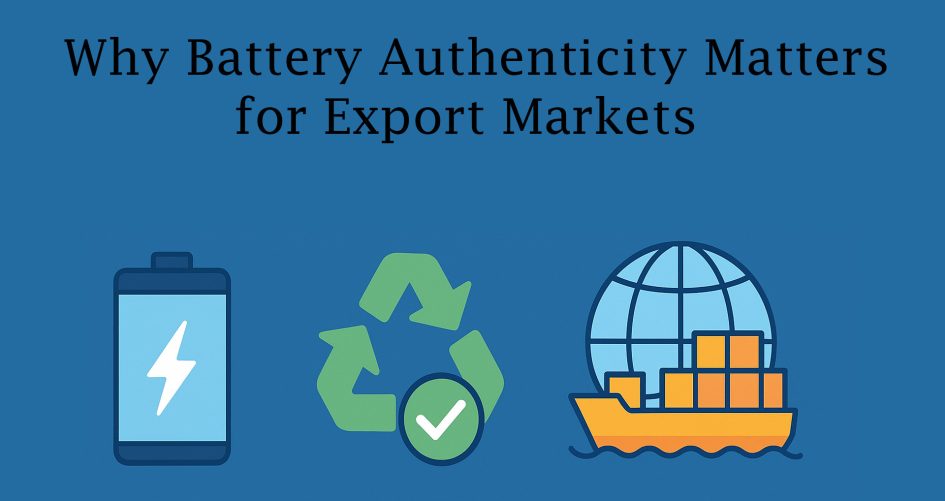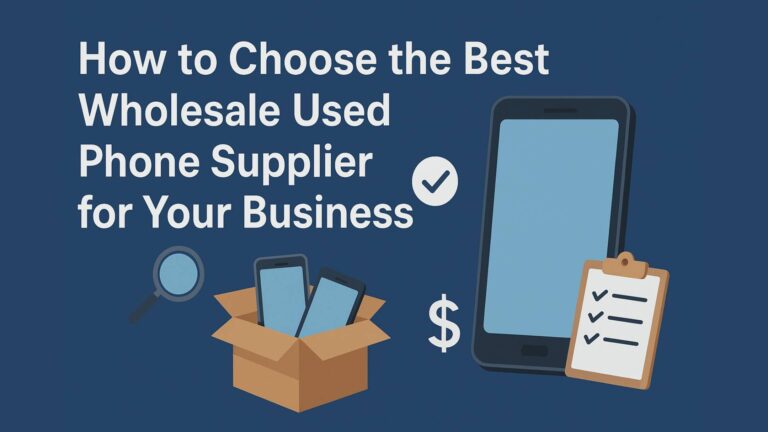When it comes to global trade in refurbished phones and devices, battery quality verification, lithium battery export, and ensuring a safe power supply aren’t just technical steps—they’re dealmakers. In high-stakes export markets, battery authenticity isn’t optional. It’s a compliance requirement, a quality benchmark, and a key to brand trust.
In this article, we break down why battery integrity is becoming mission-critical for exporters, and how battery quality verification ensures safety, performance, and legal compliance for your lithium battery export business—all while guaranteeing a safe power supply to your global customers. Know more.
1. The Global Push for Safer, Verified Batteries
Lithium-ion batteries are powerful, compact—and volatile if mishandled. Countries around the world are tightening standards for lithium battery export, and it’s no longer enough to say your batteries work. You must prove they are safe.
From Europe’s CE marking to India’s BIS compliance to the UN38.3 certification, battery quality verification is now mandatory. And when you ship substandard or fake batteries, the results can be disastrous:
- Fire hazards during air or sea transit
- Rejected shipments at customs
- Legal liability and brand damage
- Customer injuries or product recalls
That’s why a safe power supply starts with authenticity—not just performance.
2. Why Authentic Batteries Matter in Export
Here’s why battery quality verification should be a core pillar in your lithium battery export strategy:
- Customs Clearance: Most ports won’t release devices without compliance labels and proof of certified battery testing.
- Distributor Trust: Wholesale partners want batteries that won’t cause issues for end users or require warranty replacements.
- Brand Reputation: One bad shipment of fake or unstable batteries can permanently damage your credibility in a foreign market.
- Insurance Compliance: Shipping insurance often requires evidence of a safe power supply through documentation and lab testing.
In other words: if you’re exporting mobile devices, certified, authentic batteries aren’t an upgrade—they’re the baseline.
3. Risks of Battery Fraud in the Market
The rise in lithium battery export has unfortunately opened the door to counterfeit cells and unverified refurbishments. The market is flooded with:
- Fake brand-label batteries with inferior materials
- Rewrapped used cells sold as “new”
- B-grade or reject cells from factories
- Repacked batteries missing BMS (battery management systems)
Without battery quality verification, there’s no telling what’s inside the pack. And when customers plug in, the damage can range from swelling and leaks to full explosions. That’s the opposite of a safe power supply—and a direct route to refund claims, lawsuits, and government bans.
4. What Battery Quality Verification Involves
To meet global standards for lithium battery export, every battery must be tested and verified for:
- Capacity (measured in mAh): Ensures performance and matches labeling
- Voltage and Current Stability: Detects shorts or irregular outputs
- Internal Resistance: Reveals battery health and shelf life
- Cycle Count and Rechargeability: Determines how long the battery lasts
- Temperature Tolerance: Safety under heat or cold
Labs and OEM-level refurbishers use high-end diagnostic tools like:
- Battery testers (e.g. Cadex, BK Precision)
- Thermal scanners
- Load simulators
Documentation is essential—many regions now require a full battery report as part of lithium battery export.
5. The Role of Certification in Safe Battery Export
Export-ready batteries often require certification from national or international agencies. These include:
- UN38.3: Mandatory for all lithium battery export shipments by air or sea
- IEC 62133: Global standard for rechargeable battery safety
- CB Report: For international product acceptance in over 50 countries
- RoHS / CE / FCC / BIS / PSE: Country-specific safety labels
Without proper certificates, customs can hold or destroy shipments. Worse, your customers may face penalties for importing unauthorized goods.
This is why battery quality verification is so deeply tied to compliance—and a safe power supply in every market.
6. Packaging & Shipping: The Hidden Risk Factor
Even verified batteries can pose export risks if packaging isn’t done right. Proper lithium battery export requires:
- Insulated terminals (no exposed connectors)
- Rigid inner packaging with non-conductive material
- Outer boxes labeled “Lithium Battery – Handle with Care”
- Air Waybill (AWB) declarations for lithium contents
- Inclusion of test summary (per IATA DGR Section II)
These steps not only ensure a safe power supply, they also reduce insurance premiums and eliminate rejections from logistics providers.
7. Safe Power Supply = Strong Customer Retention
Let’s get real: if you export devices with unreliable batteries, your customers won’t come back.
But when you provide verifiable, stable, long-life batteries, you:
- Build trust and loyalty
- Reduce RMA (return merchandise authorization) costs
- Increase reseller confidence
- Strengthen word-of-mouth in foreign markets
And remember: the battery is the most likely failure point in a refurbished phone. So proving a safe power supply is the #1 way to retain international customers long term.
8. Repackaging & Rebuilding: A Trusted Path When Done Right
Repackaged or rebuilt batteries aren’t inherently unsafe—IF they follow strict battery quality verification guidelines. That means:
- New cells from trusted suppliers
- Rebuilt packs using original PCBs and BMS
- Sealed, ESD-safe environments
- Real-world testing post-assembly
Some of the most successful lithium battery export companies specialize in high-quality rebuilt batteries with performance better than OEM. But they always provide full data sheets, test logs, and packaging specs to guarantee a safe power supply.
9. Industry Trends Pushing Verification to the Forefront
Refurbished mobile wholesalers now face increasing pressure to step up battery verification:
- Amazon, eBay, and Walmart require battery test proof for listings
- Air cargo providers reject unlabeled or uncertified packages
- Buyers in Africa, the Middle East, and Southeast Asia now demand certificates of conformity
- Insurance providers tie liability policies to battery quality
These trends are accelerating—and any serious lithium battery export operation needs airtight processes in place.
10. How to Build a Verification Pipeline for Export
Want to future-proof your mobile exports with authentic, compliant batteries? Here’s how:
✅ Step 1: Source Certified Battery Stock
Use suppliers with traceability and batch testing. Avoid white-label or “no brand” cells.
✅ Step 2: Test Every Batch
Invest in test benches. Log cycle count, voltage, IR, and temperature. Archive reports.
✅ Step 3: Get Certified
For each model and market, obtain proper certs (UN38.3, IEC, CE, etc.).
✅ Step 4: Label & Package According to Standard
Use official lithium labeling and correct UN IDs. Follow IATA guidelines.
✅ Step 5: Train Staff
Ensure your team knows safe handling, inspection, and documentation standards.
✅ Step 6: Communicate Value to Customers
Make battery safety and authenticity part of your brand story.
When you commit to battery quality verification, you don’t just avoid problems—you create a competitive edge in a fast-growing, safety-first market.
Final Thoughts
Battery authenticity isn’t just a spec detail—it’s a foundation. Whether you’re a mobile distributor, refurbisher, or B2B wholesaler, reliable battery quality verification, compliant lithium battery export protocols, and a focus on delivering a safe power supply are now the minimum standard for global success.
Your batteries fuel your reputation. Make sure they’re tested, certified, and protected—because that’s how trusted exporters win the future. Know more.





